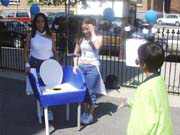"Peace is a process of responding to diversity and conflict with tolerance, imagination and flexibility."
This is the gospel according to Columbus School Principal Frank Acinapura, who last week joined other faculty members and students in celebrating the second annual Union City "Peace Day."
The all-day celebration included music, food and a number of carnival games, including a dunk tank. Word was that Acinapura had volunteered to be "dunked," but at the time of The Reporter‘s visit, the principal remained dry.
According to Columbus School computer teacher and Student Council advisor Jorge Diaz, "Everything on this day surrounds peace and anti-violence. At the beginning of the day, we watch videos and movies with the kids than discuss various points about conflict resolution."
As kids move towards high school age (the Columbus School houses sixth, seventh and eighth grades), the many social and physical adjustments can lead to conflict. And resolving these issues is what Peace Day was all about.
According to teacher Charlie Roussel, "We [the teacher mediators] act as a go-between for the students and the administration. There are students that are ‘peer mediators’ themselves."
The "peer mediators," according to school officials, are specially-trained students from other city schools who go through eight to 10 hours of training, which is done through "Peace Roots," a program coordinated and assisted by Montclair State University legal studies professor Barbara Nagle. According to Nagle, "Peace Roots provides training for teachers, students and parents throughout the state in different methods of conflict resolution. It’s almost a social skills development program."
Unique challenges
Aside from the normal rigors of growing up, kids from Union City are faced with the challenges of living in a crowded urban locale.
Said to teacher Charlie Roussel, "[Union City] is a city area, and the kids are doing the best they can. It’s about respect. If they feel that they’ve been disrespected, they’re going to stand up for themselves. And to that end, part of the day’s schedule is set aside for mentoring discussions. And the kids go through talks about how to get through problems."
Added Roussel, "Trying to get the point across is difficult, but we hope. We try."
The most interesting aspect of this program is the involvement of the student "peer mediators." According to school officials, the idea is that conflicting students will most likely respond better to those people of their own age, perhaps be a little more open. All of this, hopefully, leads to conflict resolution before a fight begins.
According to Student Peer Mediator Felipe Lara, 14, "When there’s a fight, I speak to the people that are fighting and try to help them come up with an agreement." Added Lara, "Usually, it’s a misunderstanding that causes a lot of these fights and conflicts. There’s name-calling, pushing, stuff like that. But it almost never comes to a real fight." As for why he chose to become a student peer mediator, Lara said, "I like helping people with their problems."
Fifteen-year-old Claire Reyes pulls double duty as a member of the Student Council and as a student peer mediator. She explained her reasons for being involved. Said Reyes, "I do peer mediation because it’s interesting. We can’t really give ‘advice,’ but we can lead those in dispute to reaching a mutual agreement."
